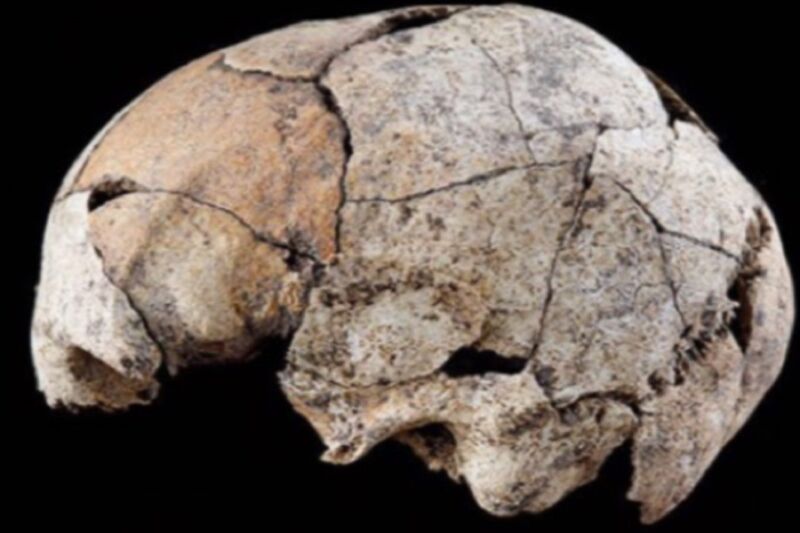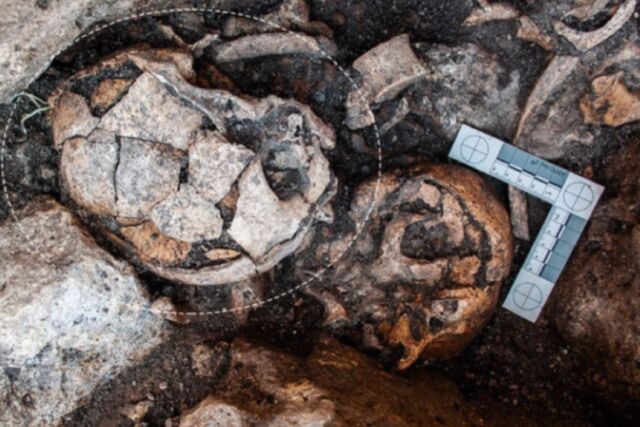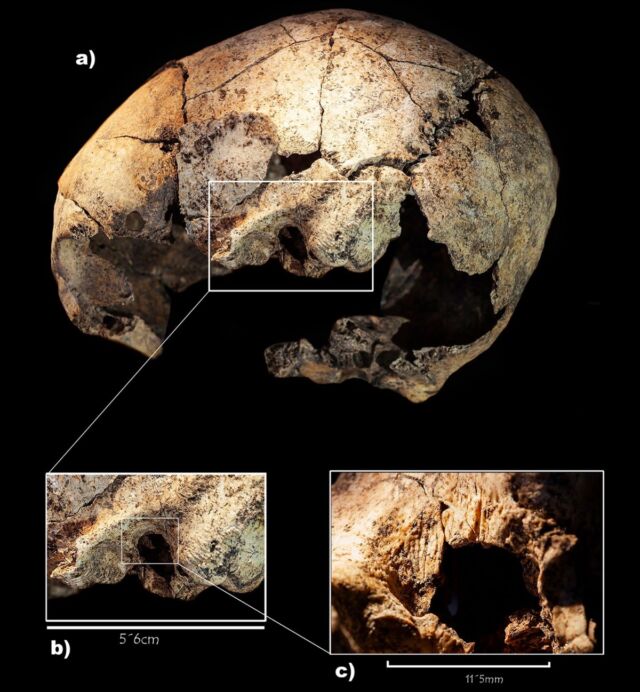
ÑFotógrafos Images Research
Archaeologists have excavated a 5,300-year-old cranium from a Spanish tomb and decided that seven lower marks close to the left ear canal are sturdy proof of a primitive surgical process to deal with a center ear an infection. That makes this the earliest identified instance of ear surgical procedure but discovered, in response to the authors of a latest paper printed within the journal Scientific Experiences. The Spanish group additionally recognized a flint blade that will have been used as a cauterizing device.
The excavation website is positioned within the Dolmen of El Pendón in Burgos, Spain, and consists of the stays of a megalithic monument courting again to the 4th century BCE, i.e., the late Neolithic interval. The ruins embody an ossuary holding the bones of practically 100 folks, and archaeologists have been excavating these stays since 2016.
In July 2018, the group recovered the cranium that's the topic of this newest research. The cranium was mendacity on its proper facet, going through the doorway of the burial chamber, and whereas a lot of the skull was intact, no tooth remained. The lacking tooth, plus the loss in bone density and absolutely ossified thyroid cartilage, indicated that this was the cranium of an aged girl aged 65 or older.

S. Diaz-Navarro et al., 2022
Proof of perforations had been discovered on either side of the cranium close to the mastoid bones (positioned simply behind the ear). The authors advised that these perforations had been the results of two surgical interventions, one on every ear, by somebody with rudimentary anatomical data. There was extra bone reworking on the fitting ear, indicting that the primary surgical procedure was carried out to deal with what was doubtless a life-threatening situation, given the dangers related to such a process throughout this era.
The girl survived the primary process and endured a second surgical procedure on the left ear someday after. The authors had been unable to find out whether or not the procedures had been performed back-to-back or whether or not months and even years handed between them. Regardless, "It's thus the earliest documented proof of a surgical procedure on each temporal bones and due to this fact, almost certainly, the primary identified radical mastoidectomy within the historical past of humankind," they wrote.
This was a reasonably frequent surgical process to deal with acute ear infections by the seventeenth century, per the authors, and skulls displaying proof of a mastoidectomy have been present in Croatia (eleventh century), Italy (18th and nineteenth centuries), and Copenhagen (nineteenth or early twentieth century). Maybe the oldest sort of cranium surgical procedure is cranial trepanation—the drilling of a gap within the head—which has been well-documented alongside the Iberian Peninsula. 5 skulls recovered from a website near the Dolmen of El Pendón confirmed proof of trepanation, and the people apparently survived these procedures, regardless of the shortage of antibiotics and a excessive danger of issues.

S. Diaz-Navarro et al., 2022
What situation may need prompted such an intervention? The authors dominated out a cholesteatoma—an harm to the temporal bone that may trigger listening to loss, vertigo, and different issues—though this is likely one of the most well-documented ailments in pathological research of historical skulls. However cholesteatoma tends to erode the bony wall (scutum) separating the ear canal from the mastoid, and the scutum was intact on either side of the lady's cranium. The authors additionally dominated out a bone tumor or malignant exterior otitis (a fast-spreading an infection of the ear canal and temporal bone).
The authors concluded that the almost certainly situation was acute otitis media, aka a center ear an infection, which had unfold to the underlying bone, particularly the mastoid bone (mastoiditis). The situation would have been simple sufficient to diagnose, because the an infection causes seen swelling and redness as fluid and mucus construct up contained in the ear. If a center ear an infection unfold to the mastoid bone, the bone's honeycomb-like construction would have additionally crammed with fluid and mucus. Untreated, this is able to have led to listening to loss and presumably meningitis. Mastoiditis ensuing from a center ear an infection was one of many main causes of dying in youngsters previous to the broad availability of antibiotics (and it's mercifully a uncommon situation right this moment).
A contemporary mastoidectomy entails eradicating the cells within the mastoid bone's hole air-filled areas. In a radical mastoidectomy, the surgeon will first make a lower behind the ear after which use a bone drill to open entry to the center ear cavity. Then the surgeon will take away any contaminated mastoid bone or tissue, sew up the lower, and bandage the wound. Per the authors, their late Neolithic ear surgeon would have adopted the same (albeit a lot cruder) process, eradicating the affected bone to empty the center ear after which connecting the mastoid bone with the tympanic cavity surrounding the bone of the inside ear.



0 Comments